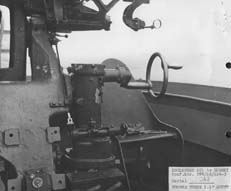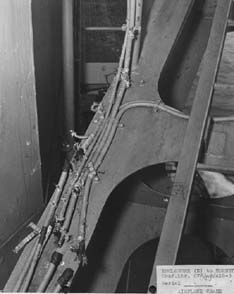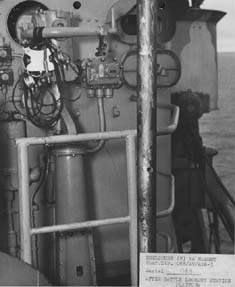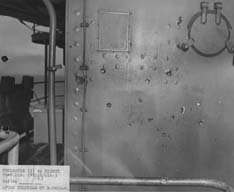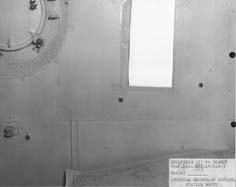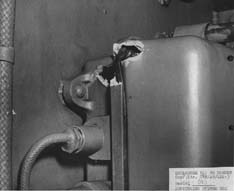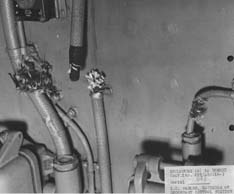CV8/A9/A16-3/A9
(043) |
OF12-Mn |
| CONFIDENTIAL |
12 June 1942. |
| Subject: |
U.S.S. HORNET (CV8) - Report of Damage to Ship's Structure by Machine Gun Fire. |
- - - - - - - - - - - - - - - - - - - - - - - - - - - - - - - - - - - - - - - - - - - -
Enclosure (E): Airplane Crane. One or more projectiles tore through the cables on the inboard side of the crane and passed on to strike the pelorus stand (F) and starboard 36 inch searchlight (G). There were three holes in the fifth web (20# plate) and one hole in the sixth web (15# plate) from the base of the crane. The sixth web was also battered slightly due to being struck by the projectiles that passed through the fifth web. Range about 140 feet.
Enclosure (F): Base of after atarboard pelorus stand. One projectile entered base of stand but did not pass through the other side (evidently a tracer bullet). Range about 160 feet.
Enclosure (G): Starboard 36 inch searchlight, after cover. Projectile penetrated plate and slightly frayed the aperture device (which was later repaired by filing the edges) but did not damage the mirror. Range about 180 feet.
Enclosure (H): After Battle Lookout station. Projectile passed through vertical antenna. Another projectile not shown passed through 40# STS at the top of lookout station, passed through the angle of the stiffener inside and ricocheted off the overhead. Range about 145 feet. One projectile struck the aide of the after 5 inch director tower making an indentation about one quarter of an inch deep.
Enclosure (I): After bulkhead of Secondary Control Station, B-0605-C. There are three projectile holes in this bulkhead, (30# STS). There are six other places where projectiles struck: but did not penetrate. Of the three that passed through the bulkhead, one pasaed through the webbing of the stiffener of the doorway at frame 104 port in Secondary Conn, while the two others passed into the antenna trunk on the forward port side of the compartment severing the antenna.
Enclosure (J): Interior Secondary Control Station booth showing holes through sheathing made by projectlies described under (I).
- 2 -
|


